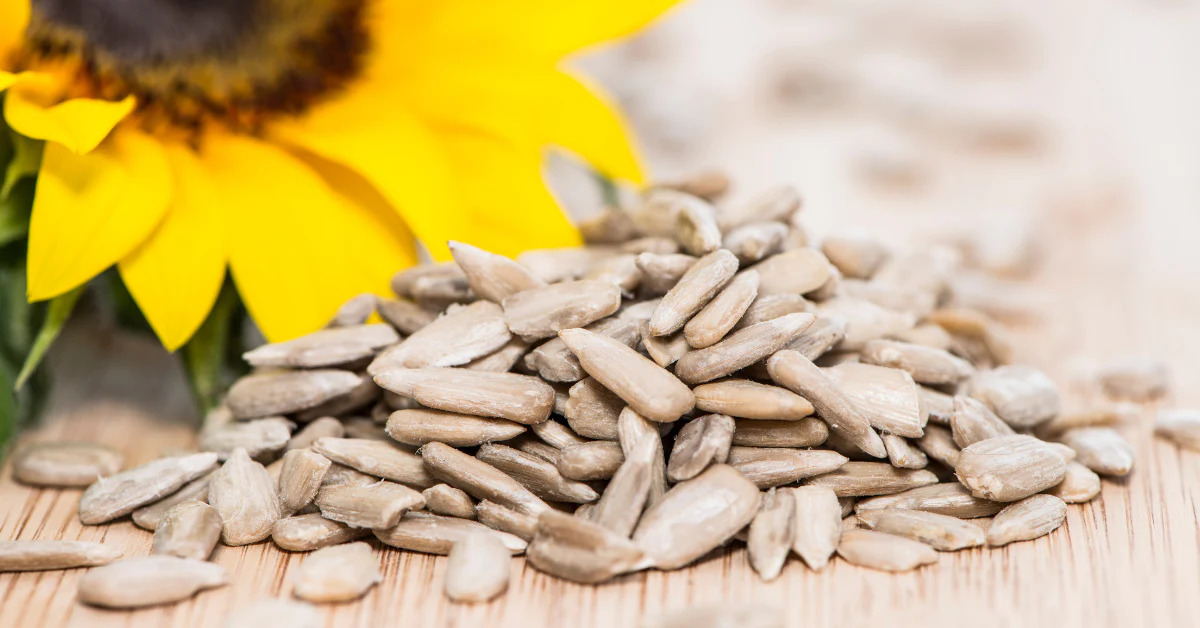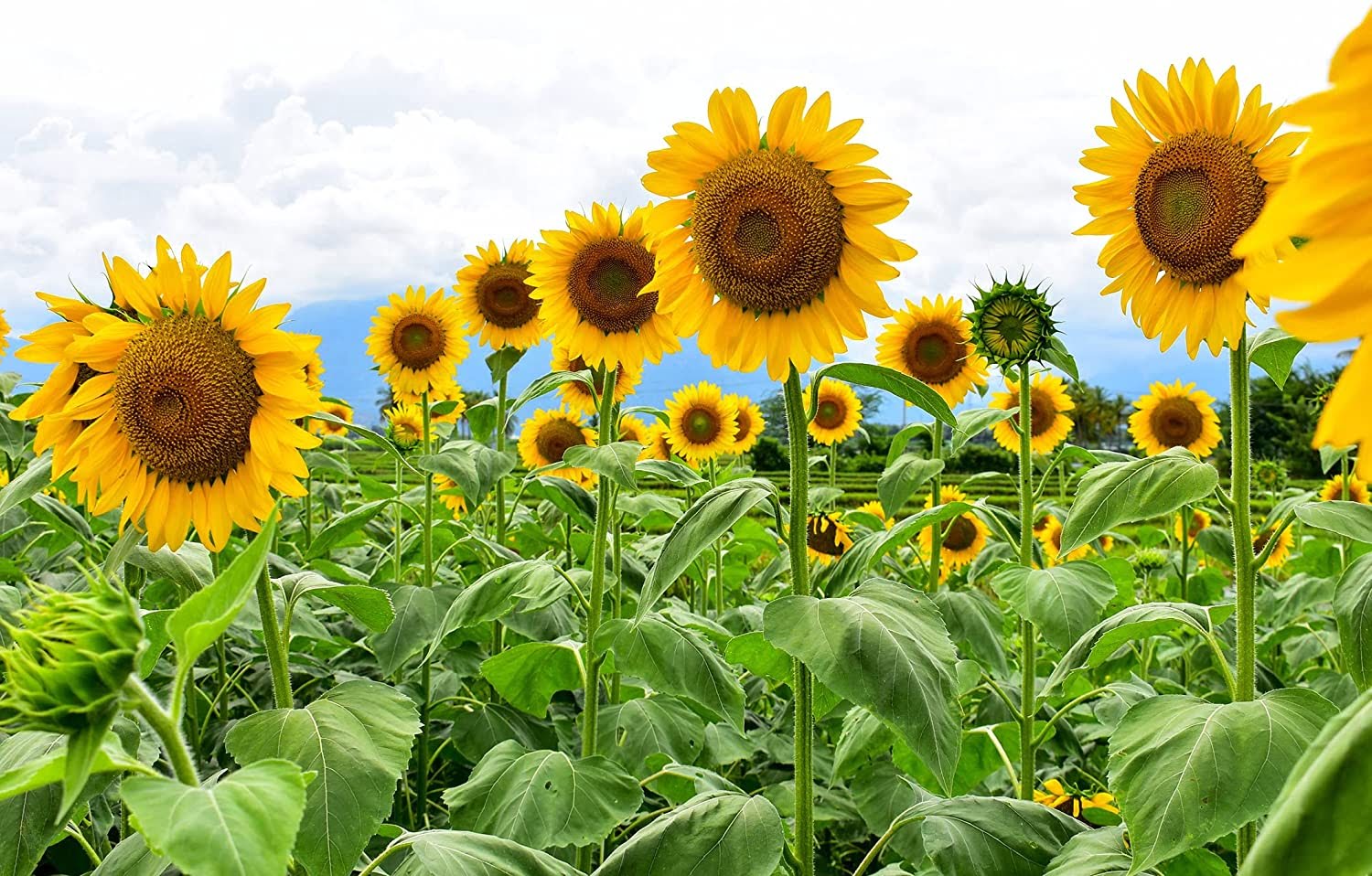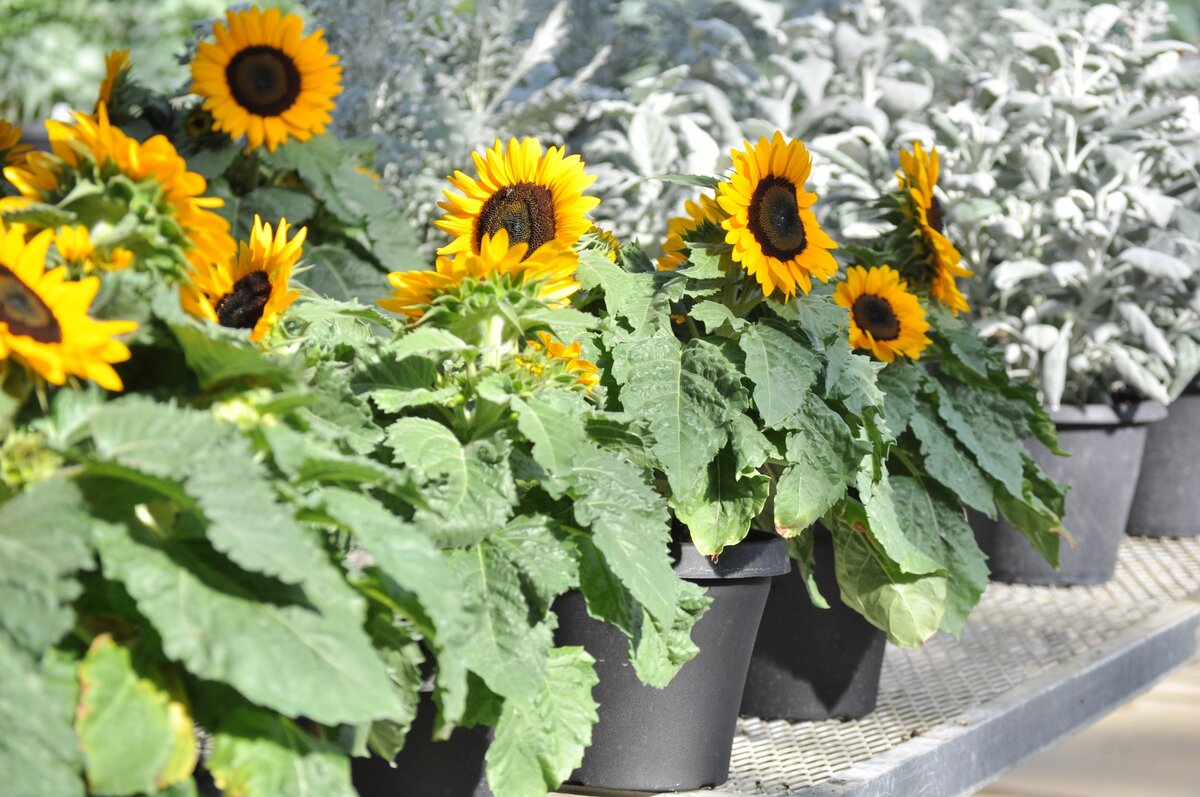Home>Types of Gardening>Ornamental Gardening>How Do Sunflowers Produce Carbohydrates


Ornamental Gardening
How Do Sunflowers Produce Carbohydrates
Modified: January 22, 2024
Learn how sunflowers produce carbohydrates and their role in ornamental gardening. Discover the process and benefits of cultivating sunflowers for a vibrant garden display.
(Many of the links in this article redirect to a specific reviewed product. Your purchase of these products through affiliate links helps to generate commission for Chicagolandgardening.com, at no extra cost. Learn more)
Table of Contents
Introduction
Welcome to the fascinating world of sunflowers! These stunning and vibrant plants have captivated gardeners and nature enthusiasts for centuries. With their large, vibrant yellow petals and towering heights, sunflowers are not only aesthetically pleasing but also play a vital role in the ecosystem. In this article, we will explore the intriguing process of how sunflowers produce carbohydrates, which are essential for their growth and survival.
Sunflowers, scientifically known as Helianthus, belong to the Asteraceae family, which includes daisies and asters. They are native to North and South America but can now be found in gardens and fields across the globe. The iconic yellow blooms of sunflowers are not just visually striking; they are also responsible for the incredible production of carbohydrates.
Carbohydrates are organic compounds that serve as a primary source of energy for plants. They are made up of carbon, hydrogen, and oxygen atoms and are produced through the process of photosynthesis. Sunflowers, like other plants, are autotrophic, meaning they have the ability to synthesize their own food through photosynthesis.
The process of photosynthesis in sunflowers takes place in their green, leafy structures. Sunflowers have large, broad leaves that maximize their surface area for maximum absorption of sunlight. Through the intricate process of photosynthesis, sunlight is converted into chemical energy in the form of carbohydrates.
In this article, we will delve into the structure and physiology of sunflowers, explore the process of photosynthesis, understand the crucial role of leaves in carbohydrate production, discuss the distribution and storage of carbohydrates in sunflowers, and examine the factors that can affect carbohydrate production. By the end of this article, you will have a comprehensive understanding of the magical process through which sunflowers produce the carbohydrates they need to thrive.
The Structure and Physiology of Sunflowers
Sunflowers are remarkable plants that possess unique features in their structure and physiology. Understanding these aspects is crucial to comprehend how sunflowers produce carbohydrates. Let’s explore the key elements of sunflower anatomy and physiological processes.
The most recognizable feature of sunflowers is their large flower head. This disc-shaped arrangement is composed of hundreds or even thousands of tiny individual flowers called florets. The florets are nestled tightly together, creating the appearance of a single, impressive bloom. The vibrant yellow petals surrounding the disc attract pollinators and add to the sunflower’s charm.
Below the flower head, sunflowers have a sturdy, thick stem that provides support to the plant’s height and weight. The stem also plays a vital role in nutrient transport, allowing water and minerals to travel from the roots to the rest of the plant.
The leaves of sunflowers are another crucial component of their structure. Sunflower leaves are broad, simple, and arranged in an alternating pattern along the stem. These leaves have a waxy cuticle on their surface, which helps reduce water loss through evaporation.
The primary function of sunflower leaves is to perform photosynthesis. Within the leaves’ cells, there are specialized structures called chloroplasts that contain chlorophyll. Chlorophyll is the pigment responsible for capturing sunlight and initiating the photosynthetic process.
In addition to photosynthesis, the leaves also play a vital role in transpiration. Transpiration is the process by which water evaporates from the leaves, creating suction that pulls water and nutrients from the roots upward through the stem. This continuous movement of water and nutrients is essential for the sunflower’s growth and the transportation of carbohydrates.
Furthermore, sunflowers have an intricate root system that extends deep into the ground. The roots of sunflowers are responsible for anchoring the plant in the soil and absorbing water and essential minerals. They possess fine root hairs, which increase their surface area and enhance nutrient absorption.
By understanding the structure and physiology of sunflowers, we can begin to grasp how these fascinating plants produce carbohydrates. Next, let’s explore the process of photosynthesis, which is the key mechanism behind carbohydrate production in sunflowers.
Process of Photosynthesis
Photosynthesis is a complex biochemical process that takes place in the chloroplasts of sunflower leaves. It is the primary mechanism through which sunflowers produce carbohydrates, essential for their growth and survival.
The process of photosynthesis can be summarized in three main stages: light absorption, electron transport, and carbohydrate synthesis.
During the first stage, light absorption, sunlight is captured by the chlorophyll pigment present in the chloroplasts. Sunflowers have a high concentration of chlorophyll, giving their leaves a vibrant green color. The chlorophyll molecules absorb light energy from the sun, primarily in the red and blue wavelengths, while reflecting green light, which is why we perceive the leaves as green.
Once the light energy is absorbed, it triggers the second stage, electron transport. In this stage, the absorbed light energy is converted into chemical energy in the form of ATP (adenosine triphosphate) and NADPH (nicotinamide adenine dinucleotide phosphate).
ATP and NADPH are then utilized in the third stage, carbohydrate synthesis. Sunflowers use these energy-rich molecules to convert carbon dioxide (CO2) from the air and water (H2O) from the roots into glucose, a simple sugar and the primary carbohydrate produced during photosynthesis.
The glucose molecules synthesized in the leaves are either used immediately for energy and growth processes within the plant or transported to other parts of the sunflower through the phloem tissue for storage or distribution.
It is crucial to remember that photosynthesis requires not only sunlight but also carbon dioxide and water. In the case of sunflowers, carbon dioxide enters the plant through small openings on the underside of the leaves called stomata. Stomata can open and close to control the influx of carbon dioxide while minimizing water loss through evaporation.
In addition to photosynthesis, sunflowers also undergo respiration, a process where carbohydrates are broken down to release energy for various cellular functions. This occurs in the mitochondria of sunflower cells and is essential for the plant’s metabolic processes.
Understanding the process of photosynthesis is key to appreciating the remarkable ability of sunflowers to convert sunlight into chemical energy. However, the successful production of carbohydrates relies not only on photosynthesis but also on the specific role of leaves in carbohydrate production. Let’s explore that in the next section.
Role of Leaves in Carbohydrate Production
The leaves of sunflowers play a crucial role in the production of carbohydrates through their involvement in the process of photosynthesis. As the primary site for photosynthesis, the leaves are responsible for capturing sunlight, converting it into chemical energy, and synthesizing carbohydrates.
The structure of sunflower leaves is optimized for efficient photosynthesis. They are broad and flat, providing a large surface area that maximizes light absorption. The green pigment chlorophyll, found within specialized organelles called chloroplasts, absorbs light energy from the sun, initiating the photosynthetic process.
Within the chloroplasts, photosynthesis occurs in two distinct regions: the grana, consisting of stacks of thylakoid membranes, and the stroma, the fluid-filled space between the grana. The grana contain the pigments and protein complexes necessary for capturing light energy, while the stroma is where carbon dioxide fixation, ATP synthesis, and glucose production take place.
Through a series of complex biochemical reactions, sunlight is converted into chemical energy in the form of ATP and NADPH. These energy-rich molecules are produced in the chloroplasts and serve as the driving force for carbohydrate synthesis.
Carbon dioxide (CO2) from the air enters the sunflower leaves through tiny openings called stomata. Inside the chloroplasts, carbon dioxide combines with the ATP and NADPH generated through photosynthesis to undergo a series of enzymatic reactions known as the Calvin cycle or the dark reactions.
During the Calvin cycle, the carbon dioxide is converted into glucose, a simple sugar and the primary carbohydrate produced by sunflowers. This glucose serves as an immediate energy source for the plant’s metabolic processes or is stored as starch for future use.
Additionally, the leaves also play a vital role in transpiration, the process of water movement through the plant. As water evaporates from the surface of the leaves, it creates a suction force that draws up water and nutrients from the roots, facilitating the delivery of essential components for photosynthesis.
Overall, the leaves of sunflowers are essential for carbohydrate production through their involvement in photosynthesis, the conversion of sunlight into chemical energy. Their specialized structure, abundance of chlorophyll, and efficient carbon dioxide uptake make them critical contributors to the growth and development of sunflowers.
Now that we understand the role of leaves in carbohydrate production, let’s explore how sunflowers distribute and store these essential energy sources throughout their structures.
Distribution and Storage of Carbohydrates in Sunflowers
Once carbohydrates are synthesized in sunflowers through the process of photosynthesis, they are distributed and stored strategically to meet the plant’s energy needs. Carbohydrates serve as a vital source of energy for growth, reproduction, and survival.
The distribution of carbohydrates in sunflowers mainly occurs through the phloem tissue, which acts as a transportation system within the plant. The phloem is composed of specialized cells called sieve tubes, which are interconnected to form a network throughout the sunflower’s stem, leaves, and other tissues.
Carbohydrates, primarily in the form of sucrose, are loaded into the sieve tubes in the leaves. This loading process requires energy and occurs through active transport mechanisms. Once loaded, sucrose travels through the phloem, driven by pressure gradients, towards sinks or areas of carbohydrate demand within the plant.
Sinks are regions where the stored carbohydrates are utilized or stored for various purposes. Some common sinks in sunflowers include developing flowers, developing seeds, growing roots, and actively growing shoots. These sinks have high metabolic activity and require a constant supply of carbohydrates for growth and development.
When carbohydrates reach a sink, they are unloaded from the phloem and either consumed for immediate energy needs or stored for later use. In developing flowers, carbohydrates are utilized for petal and ovule growth, facilitating successful pollination and seed formation.
Once pollination occurs, the developing seeds become major carbohydrate sinks. Carbohydrates are transported to the growing seeds, providing the energy necessary for embryo development and seed filling. The stored carbohydrates in the seeds supply nutrients to the germinating seedling when it starts to grow.
In addition to flowers and seeds, growing roots also act as carbohydrate sinks. The energy from stored carbohydrates supports root growth and the elongation of root hairs, enhancing the plant’s ability to absorb water and nutrients from the soil.
Furthermore, actively growing shoots, including stems and leaves, require a continuous supply of carbohydrates for cell division, elongation, and leaf expansion. Carbohydrates provide the necessary energy for the production of new tissues, ensuring the sunflower’s growth and resilience.
Not all carbohydrates are immediately utilized by sinks; some are stored for future use. Sunflowers preferentially store carbohydrates in the form of starch, a polysaccharide composed of many glucose molecules. Starch is stored in various plant structures, primarily in the roots and stem, where it remains available for mobilization when needed.
Distribution and storage of carbohydrates in sunflowers is a dynamic process, with the plant carefully allocating energy resources to support growth, reproduction, and maintenance. The efficient transportation and strategic storage of carbohydrates ensure the sunflower’s overall health and ability to adapt to changing environmental conditions.
Now that we’ve explored the distribution and storage of carbohydrates in sunflowers, let’s delve into the factors that can affect carbohydrate production in these remarkable plants.
Factors Affecting Carbohydrate Production in Sunflowers
Carbohydrate production in sunflowers is influenced by various factors that can either enhance or hinder the plant’s ability to synthesize and accumulate carbohydrates. Understanding these factors can help gardeners and growers optimize the growth and productivity of sunflowers. Let’s explore some key factors that affect carbohydrate production in sunflowers.
- Light availability: Sunflowers require an adequate amount of sunlight for optimal photosynthesis. Insufficient light can limit the plant’s ability to capture and convert light energy into carbohydrates. Therefore, placing sunflowers in well-lit areas with direct sunlight exposure is essential for maximizing carbohydrate production.
- Temperature: Sunflowers thrive in warm temperatures, typically between 70°F and 85°F (21°C – 29°C). Higher temperatures can increase photosynthetic activity and carbohydrate production, while extremely hot temperatures or extreme fluctuations can stress the plant, hindering carbohydrate synthesis.
- Water availability: Adequate water supply is crucial for sunflower growth and carbohydrate production. Water is needed for photosynthesis, nutrient uptake, and maintaining turgor pressure, which is necessary for plant structure and function. Insufficient water supply can lead to reduced photosynthetic efficiency and carbohydrate synthesis.
- Nutrient availability: Essential nutrients, such as nitrogen, phosphorus, and potassium, play a vital role in the production and utilization of carbohydrates. A balanced nutrient supply promotes healthy plant growth and enhances the efficiency of photosynthesis and carbohydrate synthesis. Deficiencies or imbalances in nutrients can impair carbohydrate production in sunflowers.
- Carbon dioxide levels: Sunflowers require an adequate supply of carbon dioxide (CO2) for photosynthesis. Increasing atmospheric CO2 levels can enhance photosynthesis and promote carbohydrate production, especially under controlled environments such as greenhouses. However, excessive CO2 concentrations can disrupt the balance of other environmental factors and have unintended effects.
- Genetics and cultivar selection: Different sunflower cultivars exhibit variations in their ability to produce and utilize carbohydrates. Selecting cultivars that are known for high yields and strong photosynthetic capacity can significantly impact carbohydrate production. It is essential to choose cultivars that are well-suited to the growing region and environmental conditions.
- Plant density: The spacing and density of sunflowers can affect carbohydrate production. Crowded plants compete for resources such as light, water, and nutrients, potentially reducing photosynthetic efficiency and carbohydrate synthesis. Proper spacing between sunflowers allows for optimal resource allocation and promotes vigorous growth and carbohydrate production.
By considering and managing these factors, sunflower growers can create favorable conditions for optimal carbohydrate production. Providing the necessary environmental conditions, such as sufficient light, appropriate temperatures, and suitable water and nutrient availability, can greatly enhance the yield and quality of sunflowers.
Now that we’ve explored the factors influencing carbohydrate production in sunflowers, we have gained a comprehensive understanding of the intricate processes that govern their growth and development. Sunflowers are truly remarkable plants, harnessing the power of photosynthesis to produce the carbohydrates they need to flourish and enchant us with their beauty.
Conclusion
Sunflowers, with their vibrant blooms and impressive stature, are not only a sight to behold but also a marvel of nature’s ingenuity. Through the process of photosynthesis, sunflowers have the remarkable ability to produce and accumulate carbohydrates, essential for their growth and survival. Understanding the structure, physiology, and factors influencing carbohydrate production in sunflowers provides valuable insights into optimizing their cultivation and maximizing their productivity.
We explored the structure and physiology of sunflowers, from their iconic flower heads to their broad leaves and intricate root systems. The leaves, with their chlorophyll-rich chloroplasts, are the primary sites for photosynthesis, where sunlight is converted into chemical energy in the form of ATP and NADPH. Through a series of biochemical reactions, carbon dioxide is assimilated into glucose, the primary carbohydrate produced during photosynthesis.
The leaves also play a crucial role in transpiration, facilitating the movement of water and nutrients from the roots to the rest of the plant. Carbohydrates synthesized in the leaves are distributed to various sinks within the sunflower, such as developing flowers, growing seeds, roots, and actively growing shoots. These sinks require a continuous supply of carbohydrates for growth and development.
To ensure optimal carbohydrate production, several factors come into play. Light availability, temperature, water supply, nutrient availability, carbon dioxide levels, genetics, cultivar selection, and plant density all influence the rate and efficiency of carbohydrate synthesis. By providing ideal growing conditions and selecting appropriate cultivars, gardeners and growers can enhance carbohydrate production in sunflowers.
In conclusion, sunflowers are not only beautiful ornamental plants but also fascinating organisms that harness the power of photosynthesis to produce and store carbohydrates. By understanding their structure, physiology, and the factors that affect carbohydrate production, we gain insights into how to nurture and cultivate these remarkable plants successfully. So whether you’re growing sunflowers in your garden or simply admiring them in their natural habitat, take a moment to appreciate the intricate processes that allow these radiant flowers to thrive.









